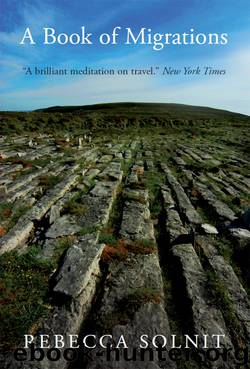A Book of Migrations by Rebecca Solnit

Author:Rebecca Solnit
Language: eng
Format: epub, azw3
Tags: A Book of Migrations
ISBN: 9781844678143
Publisher: Verso Books
Published: 2011-10-06T16:00:00+00:00
10
And a Pound of Lead
There was an implicit analogy throughout the ITA conference between the two exotics brought in to flesh out or ground the transpersonal psychology, the Irish and the Native Americans, an analogy that was never articulated. It’s one with an ancient lineage, dating back to the Tudor era, when the English were colonizing Ireland and, soon afterwards, the eastern edges of North America, and it’s survived into the present. When the plantation of Ulster—that is, Ulster’s violent colonization and conversion to a market economy—began, one of its executors, Fynes Moryson, wrote that the program should be carried out with “no less cautions . . . than if these new colonies were to be led to inhabit among the barbarous Indians.” The historian Nicholas Canny comments, “It was ominous for both the Irish and the American Indians that authors frequently made cross-cultural references, thereby implying that the two were descended from the same primitive ancestors or that they were at the same retarded state of cultural development.” In 1600, a mediocre poet wrote of the Irish kerns, or mercenaries:
Fraught with all vice, replete with villainy
They still rebel and that most treacherously.
Like brutish Indians these wild Irish live;
Their quiet neighbors they delight to grieve.
Some contemporaries compared the Irish instead to other exotic peoples, to Russians and Tartars, for example. The poet and colonial administrator Edmund Spenser went to great lengths to demonstrate the Irish were really barbaric Scythians; and an anonymous tract by a Munster landowner from the 1620s or 1630s sets out to demonstrate that Irish serfs were descended from demons, not humans. Many explorers of North America compared the peoples they encountered to the Irish for their material culture, for weapons, trousers; George Percy, walking near Jamestown, Virginia, in 1607, even compared a pathway he came across to an Irish bog or forest road.
Such comparisons were still being made two centuries later when Alexis de Tocqueville and his friend Gustave de Beaumont toured Ireland after Tocqueville’s more celebrated investigation of democracy in America. “I defy you, my dear cousin,” he wrote in a letter, “whatever efforts of the imagination you may make, to picture the misery of the population of this country. Every day we enter mud houses, covered with thatch, which do not contain a single piece of furniture, except a pot to cook the potatoes. I should have believed myself returned to the huts of my friends, the Iroquois, if I saw a hole made to allow the smoke to escape. Here the smoke goes out by the door, which gives, according to my weak lights, a decided advantage to the architecture of the Iroquois.” By the middle of the nineteenth century and the height of the Famine, The Times of London could rejoice, “In a few more years, a Celtic Irishman will be as rare in Connemara as is the Red Indian on the shores of Manhattan”; the Irish were not only like Native Americans but would be displaced with the same disregard.
But by the end of that century, the values accorded the analogies had begun to shift.
Download
This site does not store any files on its server. We only index and link to content provided by other sites. Please contact the content providers to delete copyright contents if any and email us, we'll remove relevant links or contents immediately.
Asking the Right Questions: A Guide to Critical Thinking by M. Neil Browne & Stuart M. Keeley(5355)
Autoboyography by Christina Lauren(5085)
Dialogue by Robert McKee(4160)
Eat That Frog! by Brian Tracy(4149)
Sticky Fingers by Joe Hagan(3911)
Journeys Out of the Body by Robert Monroe(3460)
Annapurna by Maurice Herzog(3296)
Full Circle by Michael Palin(3268)
Elements of Style 2017 by Richard De A'Morelli(3235)
Schaum's Quick Guide to Writing Great Short Stories by Margaret Lucke(3186)
The Art of Dramatic Writing: Its Basis in the Creative Interpretation of Human Motives by Egri Lajos(2857)
The Diviners by Libba Bray(2800)
Why I Write by George Orwell(2773)
The Mental Game of Writing: How to Overcome Obstacles, Stay Creative and Productive, and Free Your Mind for Success by James Scott Bell(2766)
In Patagonia by Bruce Chatwin(2755)
Atlas Obscura by Joshua Foer(2704)
The Fight by Norman Mailer(2699)
Venice by Jan Morris(2430)
The Elements of Style by William Strunk and E. B. White(2376)
